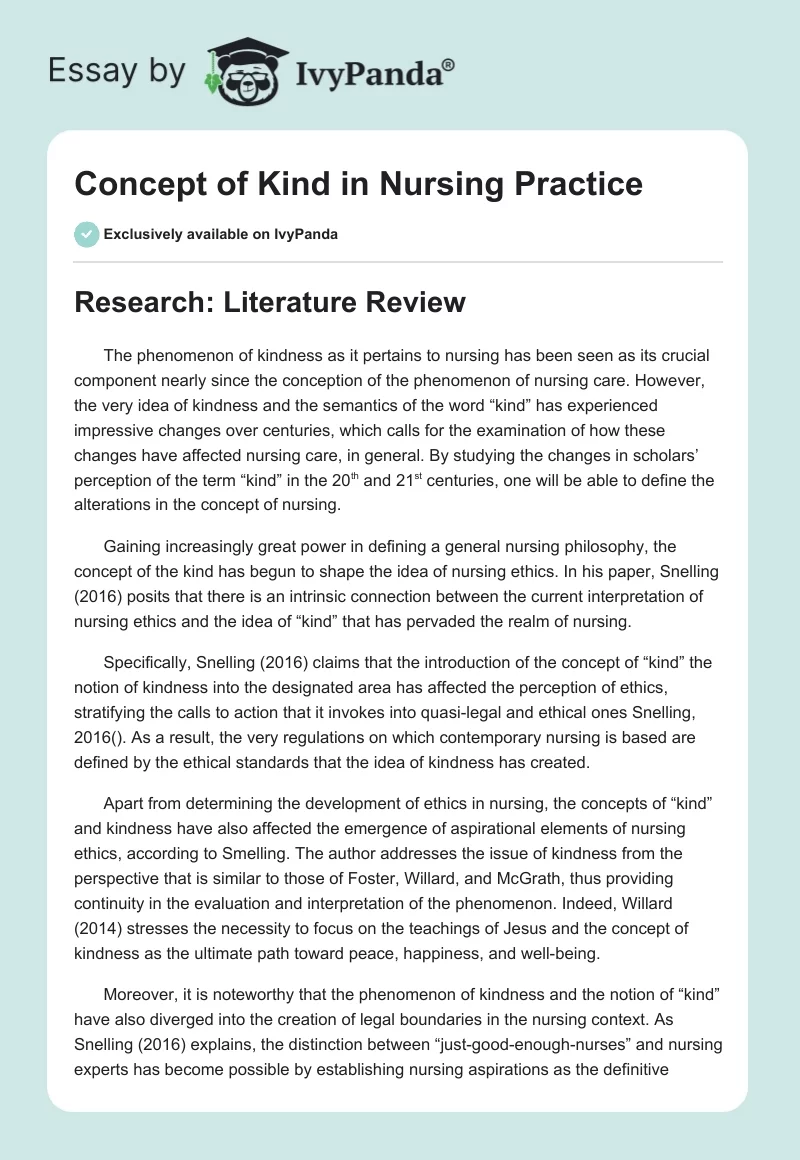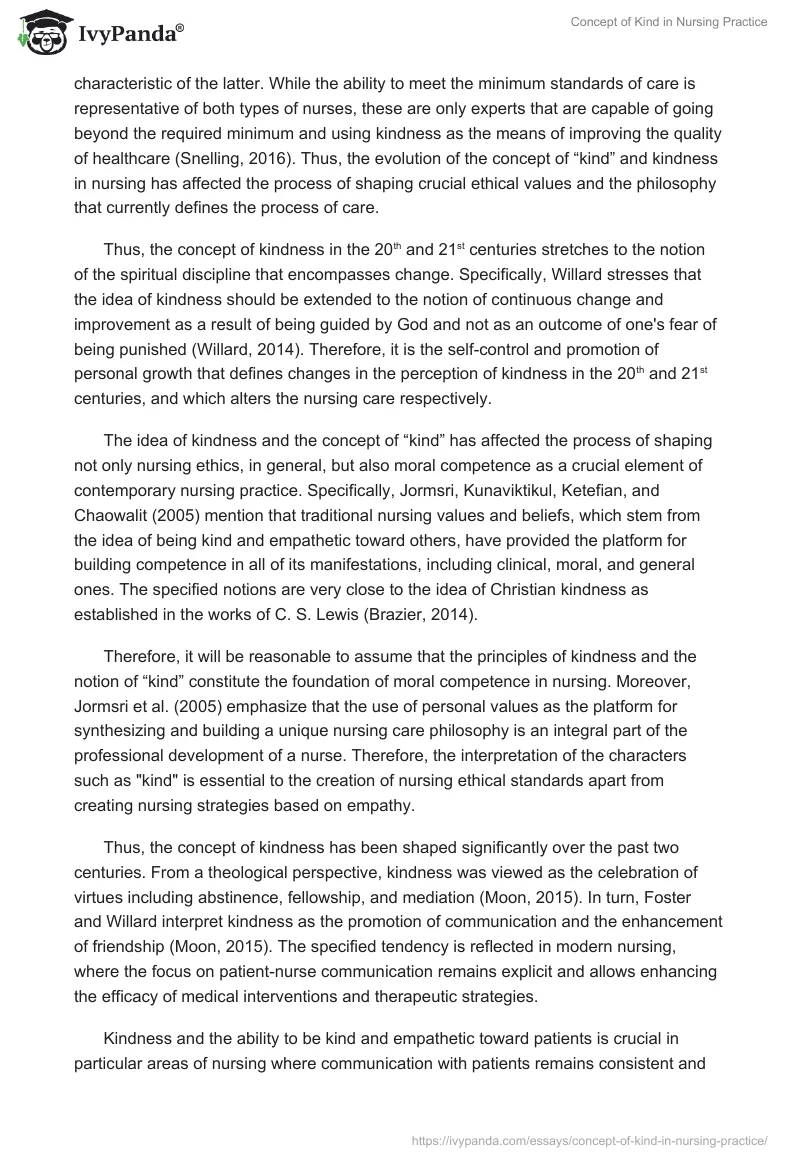Research: Literature Review
The phenomenon of kindness as it pertains to nursing has been seen as its crucial component nearly since the conception of the phenomenon of nursing care. However, the very idea of kindness and the semantics of the word “kind” has experienced impressive changes over centuries, which calls for the examination of how these changes have affected nursing care, in general. By studying the changes in scholars’ perception of the term “kind” in the 20th and 21st centuries, one will be able to define the alterations in the concept of nursing.
Gaining increasingly great power in defining a general nursing philosophy, the concept of the kind has begun to shape the idea of nursing ethics. In his paper, Snelling (2016) posits that there is an intrinsic connection between the current interpretation of nursing ethics and the idea of “kind” that has pervaded the realm of nursing.
Specifically, Snelling (2016) claims that the introduction of the concept of “kind” the notion of kindness into the designated area has affected the perception of ethics, stratifying the calls to action that it invokes into quasi-legal and ethical ones Snelling, 2016(). As a result, the very regulations on which contemporary nursing is based are defined by the ethical standards that the idea of kindness has created.
Apart from determining the development of ethics in nursing, the concepts of “kind” and kindness have also affected the emergence of aspirational elements of nursing ethics, according to Smelling. The author addresses the issue of kindness from the perspective that is similar to those of Foster, Willard, and McGrath, thus providing continuity in the evaluation and interpretation of the phenomenon. Indeed, Willard (2014) stresses the necessity to focus on the teachings of Jesus and the concept of kindness as the ultimate path toward peace, happiness, and well-being.
Moreover, it is noteworthy that the phenomenon of kindness and the notion of “kind” have also diverged into the creation of legal boundaries in the nursing context. As Snelling (2016) explains, the distinction between “just-good-enough-nurses” and nursing experts has become possible by establishing nursing aspirations as the definitive characteristic of the latter. While the ability to meet the minimum standards of care is representative of both types of nurses, these are only experts that are capable of going beyond the required minimum and using kindness as the means of improving the quality of healthcare (Snelling, 2016). Thus, the evolution of the concept of “kind” and kindness in nursing has affected the process of shaping crucial ethical values and the philosophy that currently defines the process of care.
Thus, the concept of kindness in the 20th and 21st centuries stretches to the notion of the spiritual discipline that encompasses change. Specifically, Willard stresses that the idea of kindness should be extended to the notion of continuous change and improvement as a result of being guided by God and not as an outcome of one’s fear of being punished (Willard, 2014). Therefore, it is the self-control and promotion of personal growth that defines changes in the perception of kindness in the 20th and 21st centuries, and which alters the nursing care respectively.
The idea of kindness and the concept of “kind” has affected the process of shaping not only nursing ethics, in general, but also moral competence as a crucial element of contemporary nursing practice. Specifically, Jormsri, Kunaviktikul, Ketefian, and Chaowalit (2005) mention that traditional nursing values and beliefs, which stem from the idea of being kind and empathetic toward others, have provided the platform for building competence in all of its manifestations, including clinical, moral, and general ones. The specified notions are very close to the idea of Christian kindness as established in the works of C. S. Lewis (Brazier, 2014).
Therefore, it will be reasonable to assume that the principles of kindness and the notion of “kind” constitute the foundation of moral competence in nursing. Moreover, Jormsri et al. (2005) emphasize that the use of personal values as the platform for synthesizing and building a unique nursing care philosophy is an integral part of the professional development of a nurse. Therefore, the interpretation of the characters such as “kind” is essential to the creation of nursing ethical standards apart from creating nursing strategies based on empathy.
Thus, the concept of kindness has been shaped significantly over the past two centuries. From a theological perspective, kindness was viewed as the celebration of virtues including abstinence, fellowship, and mediation (Moon, 2015). In turn, Foster and Willard interpret kindness as the promotion of communication and the enhancement of friendship (Moon, 2015). The specified tendency is reflected in modern nursing, where the focus on patient-nurse communication remains explicit and allows enhancing the efficacy of medical interventions and therapeutic strategies.
Kindness and the ability to be kind and empathetic toward patients is crucial in particular areas of nursing where communication with patients remains consistent and can be deemed as an intrinsic part of the treatment process. For example, Adrian (2018) argues that, in mental health, the notion of kindness and the concept of ‘kind” has become the cornerstone for delivering high-quality care and ensuring the efficacy of therapy. Particularly, the study shows that the concept of kindness and the concept of “kind” have been elevated from attitudes that a nurse may or may not display in the course of managing patients’ needs to the philosophy that defines quality management processes and allows ensuring that the factors affecting patients’ health are properly controlled.
According to Adrian (2018), the presence of kindness and the concept of being kind also allows nurses to make correct decisions in the clinical setting, keeping them “close to helpful possibilities and away from unhelpful judgments” (p. 2). The suggested interpretation matches the theoretical perspective on kindness as Nouwen defined it (Moon, 2015). Therefore, the phenomenon of being kind in nursing has evolved from being an unnecessary yet nice addition to the nursing practice to the construct that facilitates decision-making in the nursing setting.
Finally, the effects of kindness on the outcomes of nursing strategies also need further explorations. According to Seeber (2012), the promotion of kindness in the nursing practice and the use of the specified notion to ensure peace of mind affects patients positively, causing them to recover faster. The instruments used for measuring the presence of kindness in the approach toward nursing selected by a particular nurse vary to a significant degree due to the evident presence of subjectivity in the assessment of the subject matter.
For instance, O’Brien (2015) suggests using the evaluation of personal characteristics to measure the degree of kindness, thus promoting assessments on a case-by-case basis. Seeber (2012), in turn, proposes the assessment that involves calculating changes in the staff shortage, pointing to the fact that the levels of understaffing affect the quality of care and the attitude toward nurses’ responsibilities among the target demographic to a considerable extent. Furthermore, the author focuses on the issue of culture change, thus assuming that the degree of diversity within a nursing team may affect the rates of empathy and the propensity toward kindness and understanding among nurses.
However, due to the lack of objective judgment in the evaluation of kindness and the propensity toward being kind in nurses, a range of studies struggle to provide a particular instrument or measuring the subject matter. For instance, Adrian (2018) encourages the use of critical analysis, yet there is an evident lack of measurement instruments in the overview.
Similarly, Jormsri et al. (2005) avoid introducing a comprehensive tool for measuring the degree of kindness and the propensity toward being kind among nurses, using the classification of empathy types instead. However, Snelling (2016) compensates for the lack of measuring tools, introducing several approaches to determining kindness in nurses, including the level of kindness, the presence of authorship, and the use of language, to name a few. Nonetheless, there is the necessity to create a framework for assessing the propensity among nurses to display kindness, as well as the extent to which they use this capability.
Implications for Clinical Practice
The deconstruction of kindness as a phenomenon and the introduction of the notion of being kind into the contemporary nursing environment is likely to have a tremendously positive impact on clinical practice. By encouraging nurses to focus on kindness and develop the skills of treating patients kindly, one will be able to contribute to a significant increase in the quality of nursing care. Positive changes will be observed across all domains of nursing, clinical practice being one of the first areas to experience massive improvements.
For instance, be encouraging nurses to be kind, one will foster the development of empathy in them, which will, in turn, allow nurses to build emotional intelligence (EI). EI, in turn, will be used to identify changes in patients’ well-being based on their emotions and decipher the information received from non-verbal communication correctly. As a result, fewer errors will be made in diagnosing health issues, addressing comorbid problems, and identifying health concerns at the early stages of their development.
Moreover, the use of kindness in nursing will help to change patients’ perceptions of nurses and the role that they play in the healthcare environment. As a result, the dialogue between a patient and a nurse will be improved significantly, with the further opportunity for creating In addition, the use of a kind attitude toward patients will help to increase the rates of satisfaction among them. As the article by Seeber (2012) has shown, patients are more inclined to develop a positive attitude toward the treatment process and maintain high levels of satisfaction once nurses treat them with a kind attitude.
Since the emotions experienced by patients in the clinical setting are likely to affect their further recovery and their well-being outside of the hospital setting, it is critical to introduce kindness into the modern healthcare environment and encourage nurses to be kind to their patients. Thus, vast improvements in the quality of patient outcomes can be expected, with the following drop in the readmission rates among them. Due to the significant positive outcomes that kindness in the clinical environment has on patients, it has to be viewed as one of the crucial characteristics that nurses should strive to develop.
References
Adrian, C. (2018). Valuing kindness in mental health. Kai Tiaki Nursing New Zealand, 24(8), 2.
Brazier, P. H. (2014). C.S. Lewis – On the Christ of a religious economy, 3.2: II. Knowing salvation. Eugene, OR: Wipf and Stock Publishers.
Jormsri, P., Kunaviktikul, W., Ketefian, S., & Chaowalit, A. (2005). Moral competence in nursing practice. Nursing Ethics, 12(6), 582-594.
Moon, G. W. (Ed.). (2015). Eternal living: Reflections on Dallas Willard’s teaching on faith and formation. Downers Grove, IL: InterVarsity Press.
O’Brien, A. (2015). The power of kindness. Kai Tiaki Nursing New Zealand, 21(11), 19.
Seeber, R. (2012). The kind peace of mind culture improves patient satisfaction. Rehabilitation Nursing, 37(6), 286-291.
Snelling, P. C. (2016). The metaethics of nursing codes of ethics and conduct. Nursing Philosophy, 17(4), 229-249.
Willard, D. (2014). The great omission: Reclaiming Jesus’s essential teachings on discipleship (reprint ed.). New York, NY: HarperOne.


